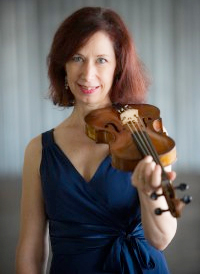by Nicholas Jones

Surrounded by Giancarlo Calicchia’s striking sculptures, Andrijeski and friends performed fascinating works by neglected 17th-century European composers.
With the support of a 2016 Creative Workforce Fellowship from the Community Partnership for Arts and Culture (funded by Cuyahoga Arts & Culture), Andrijeski is currently on research leave from her teaching and conducting duties at Case Western Reserve University. She is devoting her time to studying the enormous archive of early Baroque music for the violin, collections that are still for the most part unedited, and little performed.
Spending time in this treasure trove of music, according to Andrijeski, is like visiting one of the strange cabinets of curiosities that scholars and collectors assembled in that time of scientific and artistic exploration. In such a “Wonder Chamber” — in German, a Wunderkammer — one might encounter such diverse specimens as a stuffed crocodile, a nautilus shell, a neolithic axe, or a cloisonné bowl: things that fascinated and baffled the inquisitive minds of the times.
A sense of discovery was evident throughout the evening. While the composers included some familiar names, such as Dieterich Buxtehude and Jan Pieterszoon Sweelinck, we also heard pieces by the little-known German Johann Schop (ca. 1590-1667) and the Austrian violinist Johann Heinrich Schmeltzer (ca. 1620-1680). Naturally enough for a program delving into the archives, the prolific composer “Anonymous” was also represented by a daunting roller-coaster of virtuosity for the viola da gamba, masterfully rendered by Jaap ter Linden. Andrijeski noted that ter Linden, a native of the Netherlands, had in the 1970s done some of the early “detective” work on the manuscripts and early printings of this music.
The music of the early Baroque can seem “quirky,” as Andrijeski put it. In contrast to the music of the 18th century, these pieces are strikingly irregular, constructed around short episodes rather than extended movements, and often changing character almost without warning. Andrijeski, not only a violinist but also a dancer, embodies this variety with balletic flexibility and élan, clearly comfortable stepping gracefully through the multiplicity of affects that the music offers.
One composition, a prelude by Schop, was the occasion for Andrijeski to demonstrate something of her approach: she whimsically showed how she imagines the piece as a depiction of a fictitious family’s visit to Tregoning’s gallery, with greetings, appreciation of the works of art, and cheery farewells.
At the center of this program, Schmelzer’s music was a pleasure to hear, and to hear so convincingly interpreted. It is spirited and forceful, with a recurring dance quality punctuated with episodes of energetic and perhaps martial vigor. Someday, with the work that Andrijeski and others are putting in on this music, Schmelzer will be more accessible and better-known.
A nice touch, befitting the scholarly nature of the project, was a binder containing photocopies of manuscripts and early printings of the pieces, which gave a good sense of the daunting task of reading and transcribing the music for modern performance.
Joining Andrijeski in this intimate and informal concert, along with gambist ter Linden, were organist and harpsichordist Joseph Gascho (who presented a moving set of Sweelinck variations) and theorbist and guitarist Simon Martyn-Ellis. Double bassist Tracy Mortimore joined them for the final piece. Schmeltzer’s sonata “Das Jäger Horn” (the hunting horn) is a rollicking depiction of a hunt in which the fox apparently gets away at the end. A happy note to end a happy concert!
Published on ClevelandClassical.com November 15, 2016.
Click here for a printable copy of this article



